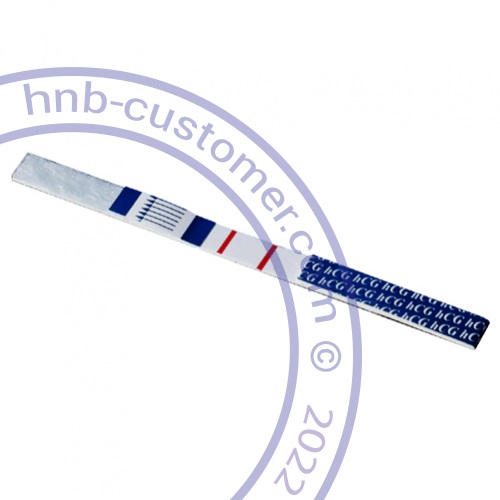Pregnancy Test Strip


Těhotenské testovací proužky – Individuálně balené testovací zarízení. Každé zařízení obsahuje anti-alfa hCG zachycené protilátkou potažené membrány a koloidní zlaté částice, potažené myší anti-beta hCG monoklonální protilátkou.
Accutest® Rapid Pregnancy Test
What is this product?
Accutest® Rapid Pregnancy Test - individually wrapped test devices. Each device contains an anti-alpha hCG capture antibody coated membrane and colloidal gold particles coated with mouse anti-beta hCG monoclonal antibody.
What should I know about Storage and Stability?
The test kit is to be stored refrigerated (2-8°C) or at room temperature (up to 30°C) in the sealed pouch for the duration of the shelf-life.
What should I know about Test Procedure?
Test device, patient’s samples, and controls shouldbe brought to room temperature (20-30°C) prior to testing. Do not open pouches until ready toperform the assay.
- Remove the test device from its protective pouch (bring the device to room temperaturebefore opening the pouch to avoid condensation of moisture on the membrane). Label thedevice with patient or control identification.
- Draw sample to the line marked on the pipette (approximately 0.2 ml). Dispense entirecontents into the sample well. For each sample or control, use a separate pipette anddevice.
- Wait for pink-colored bands to appear. Depending on the concentration of hCG, positiveresults may be observed as soon as 40 seconds. However, to confirm negative results, thecomplete reaction time of 4 minutes is required. Do not interpret results after 10 minutes.
INTERPRETATION
POSITIVE: Two distinct pink-colored bands appear, one in the patient test region and one in the control region.
NEGATIVE: Only one pink-colored band appears in the control region. No apparent pink band appears in the patient test region.
INVALID: A total absence of pink-colored bands in both regions is an indication of procedural error or that test reagent deterioration has occurred.
Notes on the interpretation of results
Negative test results in patients suspected to be pregnant should be retested with a sample obtained 48 to 72 hours later, or by performing a quantitative assay. When testing with an urine specimen, the first morning specimen would contain the highest concentration of hCG.
The shade of pink in the test band region will vary depending on the concentration of hCG present. However, neither the quantitative value nor the rate of increase can be determined by a qualitative test.
LIMITATIONS
- A number of conditions other than pregnancy including trophoblastic disease and certain nontrophoblastic neoplasms cause elevated levels of hCG. These diagnoses should be considered if appropriate to the clinical evidence.
- If a urine specimen is too dilute (i.e. low specific gravity) it may not contain representative levels of hCG. If pregnancy is still suspected, a first morning urine should be obtained from the patient 48-72 hours later and tested.
- As with all diagnostic tests, a definitive clinical diagnosis should not be based on the results of a single test, but should only be made by a physician after all clinical and laboratory findings have been evaluated.
- Immunologically interfering substances such as those used in antibody therapy treatments may invalidate the test result.
- Some samples containing very high levels of hCG (≈ 200,000 mlU/ml) may yield a test line with a color intensity lighter than what is expected. When high dose “hook effect” is suspected a 1:10 dilution of the specimen with DI H20 is recommended. The test should then be repeated with the diluted specimen.
QUALITY CONTROL
A procedural control is included in the test. A colored band appearing on the control regionis considered an internal positive procedural control, indicating proper performance and reactivereagents. A clear background in the results window is considered an internal negative proceduralcontrol. If the test has been performed correctly and reagents are working properly, thebackground will clear to give a discernible result.
It is recommended that two levels of control specimens be used with each new kit, however, eachlaboratory should follow their state and local requirements. For this purpose, we recommend theuse of Accutest® hCG (Positive and Negative) controls.
COMMENTS AND TECHNICAL ASSISTANCE
Expected Values
Healthy men and healthy non-pregnant women do not have detectable hCG by the Accutest®Rapid Pregnancy Test. HCG levels of 100 mIU/ml can be reached on the day of the first missedmenstrual period. HCG levels peak about 8-10 weeks after the last menstrual period and thendecline to lower values for the remainder of the pregnancy. Following delivery, hCG levelsrapidly decrease and usually return to normal within days after parturition.
Standardization
The Accutest® Rapid Pregnancy Test has been standardized to the World Health OrganizationFirst International Reference Preparation (IRP 75/537).
Sensitivity
The Accutest® Rapid Pregnancy Test detects urinary hCG concentrations equal to or greaterthan 20 mIU/ml (Calibrated according to the 1st IRP) as indicated by the development of a pink-colored band in the patient test region. Additionally, samples containing less than 20 mIU/mlhCG may also produce a positive result.
Specificity
The specificity of the Accutest® Rapid Pregnancy Test was determined from cross-reactivitystudies with known amounts of Luteinizing Hormone (hLH), Follicle Stimulating Hormone(hFSH), and Thyroid Stimulating Hormone (hTSH). Negative results were obtained from all testsconducted with 300 mIU/ml hLH, 1000 mIU/ml hFSH and 1000 mIU/ml hTSH.
Accuracy
Correlation with Qualitative Visual Tests - Urine: 102 randomly selected urine samples wereanalyzed by the Accutest® Rapid Pregnancy Test procedure in parallel with a commerciallyavailable qualitative visual hCG test. The results indicated complete agreement (57 positivesamples and 45 negative samples).
Additionally, 40 urine samples at the hCG concentrations of 0, 20, 40, 80, 100 mIU/ml wereblind labeled and tested with the Accutest® Rapid Pregnancy Test at three doctor’s offices andone medical laboratory. The results from this study gave 100% agreement with the expectedresults.
Interference Testing
The following substances were added to hCG-free and 20 mIU/ml hCG-spiked urine samples.At the concentrations tested, none of the substances interfered in the assay.
Acetaminophen 20 mg/dl Caffeine 20 mg/dlAcetylsalicylic Acid 20 mg/dl Gentesic Acid 20 mg/dlAscorbic Acid 20 mg/dl Glucose 2 g/dlAtropine 20 mg/dl Hemoglobin 1 mg/dl.




